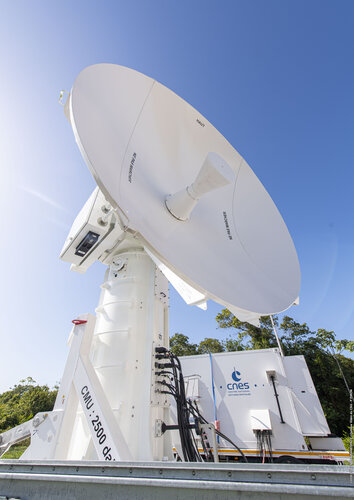
Copernical Team
Juno joins Japan's Hisaki satellite and Keck Observatory to solve "energy crisis" on Jupiter
 Sitting more than five times the distance from the Sun as Earth, Jupiter is not expected to be particularly warm. Based on the amount of sunlight received, the average temperature in the planet's upper atmosphere should be about minus 100 degrees Fahrenheit or a chilly minus 73 Celsius. Instead, the measured value soars to around 800 degrees Fahrenheit or 426 Celsius. The source of this extra he
Sitting more than five times the distance from the Sun as Earth, Jupiter is not expected to be particularly warm. Based on the amount of sunlight received, the average temperature in the planet's upper atmosphere should be about minus 100 degrees Fahrenheit or a chilly minus 73 Celsius. Instead, the measured value soars to around 800 degrees Fahrenheit or 426 Celsius. The source of this extra he North-By-Northwest for Ingenuity's 11th Flight
 We're heading northwest for the 11th flight of NASA's Ingenuity Mars Helicopter, which will happen no earlier than Wednesday night, Aug. 4. The mission profile is designed to stay ahead of the rover - supporting its future science goals in the "South Seitah" region, where it will be able to gather aerial imagery in support of future Perseverance Mars rover surface operations in the area.
H
We're heading northwest for the 11th flight of NASA's Ingenuity Mars Helicopter, which will happen no earlier than Wednesday night, Aug. 4. The mission profile is designed to stay ahead of the rover - supporting its future science goals in the "South Seitah" region, where it will be able to gather aerial imagery in support of future Perseverance Mars rover surface operations in the area.
H Helicopter scouts ridge area for Perseverance
 Ask any space explorer, and they'll have a favorite photo or two from their mission. For Kevin Hand, a scientist at NASA's Jet Propulsion Laboratory in Southern California and co-lead of the Perseverance rover's first science campaign, his latest favorite is a 3D image of low-lying wrinkles in the surface of Jezero Crater. The science team calls this area "Raised Ridges." NASA's Ingenuity Mars H
Ask any space explorer, and they'll have a favorite photo or two from their mission. For Kevin Hand, a scientist at NASA's Jet Propulsion Laboratory in Southern California and co-lead of the Perseverance rover's first science campaign, his latest favorite is a 3D image of low-lying wrinkles in the surface of Jezero Crater. The science team calls this area "Raised Ridges." NASA's Ingenuity Mars H Satellites reveal how forests increase cloud and cool climate

Forests are not only key to moderating our climate by sequestering atmospheric carbon, but they also create a cooling effect by increasing low-level cloud. A first global assessment using satellite observations has shown that for two-thirds of the world, afforestation increases low-level cloud cover, with the effect being strongest over evergreen needleleaf forest.
What it takes to become Australia's first woman astronaut

I'm currently training to become Australia's first woman astronaut. I expect to fly my first suborbital mission sometime in 2023 as a payload specialist on a commercial mission. In other words, I'll be one of few certified crew members who can handle specialized scientific equipment aboard a suborbital spacecraft.
Once we're up there, my team and I expect to conduct research on Earth's atmosphere. It's an opportunity I consider out of this world. But it has taken a lot of effort for this dream to be realized.
My path to PoSSUM
As a female STEM and legal professional, my past jobs included working as a research scientist in mining and metals for BHP-Billiton, Rio Tinto and the Australian Nuclear Science and Technology Organisation (ANSTO)—but I always loved space.
Summer stargazing treat as Perseid meteor shower reaches its peak

The Perseid meteor shower reaches its peak on the night of 11–12 August, giving skywatchers a potentially impressive summer treat. The meteors are best viewed from the northern hemisphere, and in ideal conditions with no clouds observers could see up to 50 an hour.
Meteors are the result of small particles entering the Earth's atmosphere at high speed, typically around 60 km per second.
NASA identifies likely locations of the early molten moon's deep secrets

Boeing Starliner launch delayed indefinitely

Boeing's Starliner won't launch Wednesday as had been planned following problems with its propulsion system that prevented a key uncrewed test flight to the international space station a day earlier—and it's not clear when the troubled spaceship will fly next.
The aerospace giant said in a statement that valves in Starliner's engine were in "unexpected" positions, forcing the mission team to halt the countdown.
NASA added that engineering teams have ruled out several potential causes, including a software glitch, but need more time to understand the issue.
"We're going to let the data lead our work," said John Vollmer, vice president and program manager of Boeing's Commercial Crew Program.
Impact of space station spin requires study, official says

Europe’s Spaceport gains new radar

A new additional radar called Amazonie-I installed at Pariacabo, a high point in Kourou, French Guiana, was tested during the recent Ariane 5 launch from Europe’s Spaceport.
